Improving Highway Emergency Repair Safety: Design and Evaluation of Interactive Roadblocks Based on Eye Tracking
Abstract
:1. Introduction
2. Material and Methods
2.1. Design Selection and Philosophy
2.1.1. Analysis of User Needs
- Color: Human vision has different sensitivities to different colors [30]. Red, yellow, and orange have higher brightness, which can attract attention and convey warning messages. Therefore, these colors are adopted as the main visual cue colors in the design of barricades;
- Contrast: High contrast makes targets more visible and improves visibility [31]. In barricade design, contrast is increased by combining dark and light-colored elements, for example, using black and yellow stripes on a barrier wall;
- Brightness: Brightness can affect human visibility and distance perception of objects [32]. In barricade design, the intervention of interactive components can improve the ability to prevent physical danger to workers and address the mobility of barricades, as well as improve visibility at night or in low-light conditions;
- Direction: Human vision is very sensitive to direction and shape. In roadblock design, by using arrows or other shapes to indicate the direction of a vehicle, drivers can be given a clearer picture of the road, thus reducing the risk of accidental collisions.
2.1.2. Technical Design Analysis
- Dimension Requirements: The dimensions of the barricade should be within the range of 2000 mm × 500 mm × 300 mm, ensuring effective coverage and operability within the construction area of the roadway.
- Mechanical Requirements: The barricade must be stable under high wind conditions, with a wind resistance capability of up to 200 N/m2. Additionally, it must be capable of withstanding vehicle collisions, with a minimum impact resistance of 5000 N.
- Energy Requirements: To ensure high visibility at night and in low-light conditions, the barricade design incorporates a solar power system. The photovoltaic panel has an output power of 20 W, and the high-brightness LED lights have a minimum light output intensity of 500 lumens.
2.1.3. Analysis of Related Products
- Poor Interaction: Existing roadblocks often lack effective interaction with the driver, failing to provide real-time information or warnings about road conditions, making it difficult for drivers to react quickly in emergency situations [7];
- Weak environmental adaptability: the design of barricades often does not fully take into account different environmental factors, such as urban landscape, road types, and climatic conditions, resulting in difficulties in coordinating with the surrounding environment in certain scenarios, which affects their warning effect [40];
2.2. Design Objectives
- Enhanced visibility: R-barricade is designed with a high-contrast color scheme and reflective materials, features that improve visibility at night and in adverse weather conditions, thereby reducing the risk of accidents [39];
- Enhanced warning effect: The integrated high-intensity LED warning light and dynamic signaling system are designed to attract drivers’ attention. This warning system has been proven to be effective in communicating roadside emergency repair information and improving driver reaction time [45];
- Interactive design: The interactive elements developed, such as touch-screen signage and voice-prompting features, are designed to provide real-time information and enhance communication with operators. The design emphasizes the importance of interactivity in improving work zone safety [46];
- Environmental integration: Ensure that the design of barricades is aesthetically compatible with the urban environment, use environmentally friendly materials, and consider the ease of storage and transport of barricades when they are not in use;
- User-friendliness: The design concept of the R-barricade emphasizes the importance of easy deployment, adjustment, and removal in order to reduce the physical demands on the operator and to ensure the stability of the barricade. These features are based on ergonomic principles to improve operational efficiency and reduce the risk of strain injuries [47];
- Data-driven optimization: Iterative optimization of the barricade design using data collected by eye-tracking technology to ensure that it minimizes visual distractions and improves driver response efficiency in real-world use [48].
2.3. Preliminary Design
2.4. Visual Studies
2.4.1. Visual Evaluation and Safety
- Contrast: At the heart of enhancing the visual identity of barricades, contrast reinforces the visibility of barricades in a variety of environmental conditions through purity and scale [51]. Purity focuses on the design’s colorfulness and simplicity of form to clearly communicate the barricade’s presence and importance. Proportion refers to the proportion of visual inertia to total vision, the ratio of size, quantity, and color between elements within a product [52]. It ensures that the size, shape, and color distribution of the barricade draws the attention of drivers and pedestrians without distracting them from the road conditions.
- Attractiveness: In the context of safety evaluation, visual attractiveness refers to the ability of a barricade design to attract and maintain the visual attention of motorists and pedestrians, thereby guiding them to take safe action. This includes uniqueness of design, innovation, and compatibility with the environment, aiming to create a barricade that meets safety requirements while eliciting a positive visual response.
2.4.2. Visual Evaluation Metrics and Eye Tracking
- Purity: a measure of the number of elements in a design and correlates with visual complexity. Eye tracking data show that the number of gaze points (N) is directly proportional to the number of design elements. In this case, a smaller number of elements implies higher purity, thus measuring whether the barricade design is clearly expressed and important. The formula for purity (P) is expressed as:
- Proportion: Describes the relative size and distribution between visual elements that affect visual attractiveness. According to the principle of visual inertia, the eye tends to be attracted to elements that are well-proportioned. Proportion (R) can be quantified by the variance (σ2) of gaze point duration. Proportion (R) can be quantified by the following formula:
- Contrast: A combination of purity and proportion that reflects the visual prominence of the design. A combination of purity and proportion that reflects the visual saliency of the design. According to the theory proposed by Eli Peli in 1990, the greater the variance, the more incongruous the proportionality of the visual elements. Contrast (C) can be calculated by the product of the number of gaze points and the variance [53]:
2.5. Materials
2.5.1. Eye Movement Equipment and Functions
2.5.2. Sample Selection and Processing
2.6. Experimental Design and Test Methods
2.6.1. Purpose of the Experiment
2.6.2. Selection of Experimental Subjects
2.6.3. Designing the Experimental Process
2.6.4. Experimental Procedure and Data Collection
3. Results
3.1. Eye Tracking Experimental Data
3.1.1. Analysis of Eye Tracking Experimental Data
3.1.2. Results of Eye Tracking Experimental Data
- Number of points of interest: The R-barricade design elicits more points of interest from the driver, which suggests that the driver’s attention is more focused on the roadblock, thus helping to recognize it earlier and take appropriate avoidance measures;
- Gaze duration: drivers’ longer average gaze duration at the R-barricade reflects more in-depth cognitive processing of the roadblock, which contributes to an increased awareness of the importance of the roadblock and alertness to potential hazards;
- Gaze time variance: The R-barricade’s smaller gaze time variance means that the driver’s visual attention to the roadblock is more stable, reducing the potential for delayed reactions due to distraction;
- Visual Search Efficiency: The new design of the roadblock has improved visual search efficiency, allowing drivers to locate the roadblock in the visual scene more quickly, which is especially important in emergency situations;
- Purity and proportionality: eye-tracking data shows that the R-barricade’s design effectively directs the driver’s attention allocation, enabling them to quickly notice and react to roadblocks when necessary.
3.2. Design Optimization Results
- Intelligent sensing and dynamic feedback system: In the optimized design, the R-barricade is equipped with a network of intelligent sensors that can monitor environmental conditions in real time (such as light, temperature, and wind speed) and automatically adjust the brightness, color, and frequency of the warning signals. For example, when light is insufficient, or visibility is low, the LED lights will automatically increase in brightness to ensure visibility at night or during adverse weather conditions. The sensors can also detect the speed and direction of approaching vehicles and trigger dynamic signals through rapidly flashing LED lights and an audible alarm system to alert drivers of the barricade and prompt them to take appropriate actions;
- Application of eye-tracking technology: We extensively applied eye-tracking technology not only to evaluate the design effectiveness of the barricade but also to optimize the interaction features. Eye-tracking data helped us identify and improve the key visual elements of the barricade, ensuring that it quickly captures the driver’s attention as they approach. This data-driven optimization significantly enhances the warning effect of the barricade and improves driver reaction times;
- Remote monitoring and management: The R-barricade is equipped with a wireless communication module that allows real-time connectivity with the traffic management center. Through the remote monitoring system, management personnel can instantly monitor the status of the barricade, receive abnormal alerts, and adjust the settings of the barricade as necessary. This remote management function not only increases operational efficiency but also ensures a rapid response in emergency situations;
- Self-sustaining energy and eco-friendly design: To achieve self-sustaining energy, the optimized design integrates a solar power system. The photovoltaic panels supply power to all interactive components, ensuring the barricade operates under any conditions. Additionally, eco-friendly polyvinyl chloride (PVC) material was selected [55], which has high rigidity, tensile strength, and elasticity, providing protection to vehicles and workers in high-speed impacts and reducing the risk of secondary injuries. Compared to traditional materials, this design significantly improves the stability and durability of the barricade;
- Airbag system: The optimized design also incorporates an airbag system within the top interactive module, which can be deployed immediately upon impact detection. This innovative design effectively protects the components inside the interactive module and prevents injury to vehicles and construction workers, a feature lacking in traditional barricades.
3.3. Environmental Impact and Accident Analysis
3.3.1. Accident Analysis
- Impact Protection: We analyzed the design parameters and material strength to assess the barricade’s ability to protect construction zones during a collision. Through calculations and material property analysis, we determined that the R-barricade can effectively absorb collision energy, reducing potential harm to drivers and pedestrians. Specifically, when a vehicle collides with the barricade at a speed of 50 km/h, the material of the barricade is designed to deform and absorb energy, thereby reducing the impact force on passengers inside the vehicle while simultaneously protecting workers within the construction zone;
- Material Strength: Material analysis was conducted to study the durability and impact resistance of the materials used, ensuring that they provide sufficient strength and stability during real-world accidents. The selected materials exhibit high toughness and impact resistance, maintaining structural integrity during vehicle collisions and preventing secondary injuries;
- Comparison with Safety Standards: We compared the performance of the R-barricade under different collision scenarios with relevant international and national traffic safety standards. This includes an evaluation of the deformation, stability, and secondary injury risks to vehicles after a collision. For example, theoretical calculations based on the European Standard EN 1317 indicate that after impact [56], the deformation and stability of the R-barricade remain within safe limits, ensuring that it does not pose further risks to subsequent vehicles.
3.3.2. Environmental Impact
- Environmental Friendliness of Materials: We selected sustainable materials that meet safety standards and have high recycling value;
- Long-term Impact on the Ecosystem: This includes the potential effects of light pollution and disturbances to wildlife during prolonged use;
- Preventive Measures: In the product design, we incorporated preventive measures to reduce these risks, such as optimizing material usage, reducing waste during production, and designing an efficient recycling system.
4. Discussion
4.1. Significance of Results
4.2. Research Limitations
4.3. Future Improvements
5. Conclusions
Author Contributions
Funding
Institutional Review Board Statement
Informed Consent Statement
Data Availability Statement
Acknowledgments
Conflicts of Interest
References
- Mohammed, A.A.; Ambak, K.; Mosa, A.M.; Syamsunur, D. A Review of Traffic Accidents and Related Practices Worldwide. Open Transp. J. 2019, 13, 65–83. [Google Scholar] [CrossRef]
- Ji, X.; Shao, C.; Wang, B. Stochastic Dynamic Traffic Assignment Model under Emergent Incidents. Procedia Eng. 2016, 137, 620–629. [Google Scholar] [CrossRef]
- Naqvi, N.K.; Quddus, M.; Enoch, M. Modelling the Effects of Fuel Price Changes on Road Traffic Collisions in the European Union Using Panel Data. Accid. Anal. Prev. 2023, 191, 107196. [Google Scholar] [CrossRef] [PubMed]
- Hazen, A.; Ehiri, J.E. Road Traffic Injuries: Hidden Epidemic in Less Developed Countries. J. Natl. Med. Assoc. 2006, 98, 73. [Google Scholar]
- Masilkova, M. Health and Social Consequences of Road Traffic Accidents. Kontakt 2017, 19, e43–e47. [Google Scholar] [CrossRef]
- Zhu, Q.; Liu, Y.; Liu, M.; Zhang, S.; Chen, G.; Meng, H. Intelligent Planning and Research on Urban Traffic Congestion. Future Internet 2021, 13, 284. [Google Scholar] [CrossRef]
- Jumari, M.Z.I.; Hassan, S.; Nadir, M.A.M.; Yusof, N.M.; Ikhsan, M.S.; Azman, M.A.M.N.; Sarif, M.A.F.M.; Rashid, M.A.R.A.; Aziz, N.N.A.N.; Yusof, M.S.; et al. The Signal Warning Detector (SWAD) for Sustainable Working Environment at Highways. Int. J. Integr. Eng. 2022, 14, 157–163. [Google Scholar] [CrossRef]
- Rupasinghe, B.; Wallace, M.; Gange, G.; Senthooran, I. Road Pavement Upgrade Scheduling Accounting for Minimizing Congestion. Sci. Rep. 2023, 13, 15386. [Google Scholar] [CrossRef]
- Huang, Y.; Tang, Y. Investigating the Impact Factors of Night Construction for Urban Road Projects. Front. Bus. Econ. Manag. 2022, 6, 159–164. [Google Scholar] [CrossRef]
- Ahmad, S.; Shafie, S.; Ab Kadir, M.Z.A. Power Feasibility of a Low Power Consumption Solar Tracker. Procedia Environ. Sci. 2013, 17, 494–502. [Google Scholar] [CrossRef]
- Alphonsus, E.R.; Abdullah, M.O. A Review on the Applications of Programmable Logic Controllers (PLCs). Renew. Sustain. Energy Rev. 2016, 60, 1185–1205. [Google Scholar] [CrossRef]
- Zhang, K.; Hassan, M. Crash Severity Analysis of Nighttime and Daytime Highway Work Zone Crashes. PLoS ONE 2019, 14, e0221128. [Google Scholar] [CrossRef] [PubMed]
- Pal, R.; Sinha, K.C. Analysis of Crash Rates at Interstate Work Zones in Indiana. Transp. Res. Rec. J. Transp. Res. Board 1996, 1529, 45–53. [Google Scholar] [CrossRef]
- Debnath, A.K.; Blackman, R.; Haworth, N. Common Hazards and Their Mitigating Measures in Work Zones: A Qualitative Study of Worker Perceptions. Saf. Sci. 2015, 72, 293–301. [Google Scholar] [CrossRef]
- Dobrovolny, C.S.; Arrington, D.R.; Bligh, R.P.; Kuhn, D.L. MASH Evaluation of TxDOT High-Mounting-Height Temporary Work Zone Sign Support System; No. FHWA/TX-16/9-1002-15-8; Texas A&M Transportation Institute: Bryan, TX, USA, 2017. [Google Scholar]
- Dobrovolny, C.S.; Arrington, D.R.; Bligh, R.P.; Menges, W.L. Development and MASH Full-Scale Crash Testing of a High-Mounting-Height Temporary Single Sign Support with Aluminum Sign; No. FHWA/TX-13/9-1002-12-5; Texas Department of Transportation, Research and Technology Implementation Office: Austin, TX, USA, 2013. [Google Scholar]
- Dedeji, J.A.; Hassan, M.M.; Abejide, S.O. Effectiveness of Communication Tools in Road Transportation: Nigerian Perspective. In Proceedings of the International Conference on Traffic and Transportation Engineering, Belgrade, Serbia, 24–25 November 2016. [Google Scholar]
- Steele, D.; Zabecki, J.L.M.; Zimmerman, L. Improving the Effectiveness of Nighttime Temporary Traffic Control Warning Devices, Volume 2: Evaluation of Nighttime Mobile Warning Lights; ICT-13-032 UILU-ENG-2013-2033; Illinois Department of Transportation: Springfield, IL, USA, 2013; Available online: https://www.ideals.illinois.edu/items/45997 (accessed on 5 August 2024).
- Fylan, F.; King, M.; Brough, D.; Black, A.A.; King, N.; Bentley, L.A.; Wood, J.M. Increasing Conspicuity on Night-Time Roads: Perspectives from Cyclists and Runners. Transp. Res. Part F Traffic Psychol. Behav. 2020, 68, 161–170. [Google Scholar] [CrossRef]
- Wood, J.M. Improving the Conspicuity and Safety of Pedestrians and Cyclists on Night-Time Roads. Clin. Exp. Optom. 2023, 106, 227–237. [Google Scholar] [CrossRef]
- Yu, C.-E.; Xie, S.Y.; Wen, J. Coloring the Destination: The Role of Colour Psychology on Instagram. Tour. Manag. 2020, 80, 104110. [Google Scholar] [CrossRef]
- Faltaous, S.; Baumann, M.; Schneegass, S.; Chuang, L.L. Design Guidelines for Reliability Communication in Autonomous Vehicles. In Proceedings of the 10th International Conference on Automotive User Interfaces and Interactive Vehicular Applications, Toronto, ON, Canada, 23–25 September 2018. [Google Scholar]
- Liu, Y.; Zhang, Q.; Lv, Z. Real-Time Intelligent Automatic Transportation Safety Based on Big Data Management. IEEE Trans. Intell. Transp. Syst. 2021, 23, 9702–9711. [Google Scholar] [CrossRef]
- Naveed, Q.N.; Alqahtani, H.; Khan, R.U.; Almakdi, S.; Alshehri, M.; Abdul Rasheed, M.A. An Intelligent Traffic Surveillance System Using Integrated Wireless Sensor Network and Improved Phase Timing Optimization. Sensors 2022, 22, 3333. [Google Scholar] [CrossRef]
- Selimis, V. Eye-Tracking Technology in Vehicles: Application and Design. Master’s Dissertation, City University London, London, UK, 2015. [Google Scholar]
- Michelaraki, E.; Katrakazas, C.; Kaiser, S.; Brijs, T.; Yannis, G. Real-Time Monitoring of Driver Distraction: State-of-the-Art and Future Insights. Accid. Anal. Prev. 2023, 192, 107241. [Google Scholar] [CrossRef]
- Babić, D.; Tremski, Š.; Babić, D. Investigation of Traffic Signs Understanding-Eye Tracking Case Study. Teh. Vjesn. 2019, 26, 29–35. [Google Scholar]
- Yuen, N.H.; Tam, F.; Churchill, N.W.; Schweizer, T.A.; Graham, S.J. Driving with Distraction: Measuring Brain Activity and Oculomotor Behaviour Using fMRI and Eye-Tracking. Front. Hum. Neurosci. 2021, 15, 659040. [Google Scholar] [CrossRef]
- Shen, T.; Han, Y.; Han, B.; Gao, X. Driver Eye Movement Behaviour Recognition Based on a Two-Channel Model of Human Visual Cortex. J. Intell. Syst. 2022, 17, 41–49. [Google Scholar]
- Fleishman, L.J.; Wadman, C.S.; Maximov, K.J. The Interacting Effects of Total Light Intensity and Chromatic Contrast on Visual Signal Visibility in an Anolis Lizard. Anim. Behav. 2020, 167, 263–273. [Google Scholar] [CrossRef]
- Lewandowska, A.; Olejnik-Krugly, A.; Jankowski, J.; Dziśko, M. Subjective and Objective User Behavior Disparity: Towards Balanced Visual Design and Color Adjustment. Sensors 2021, 21, 8502. [Google Scholar] [CrossRef]
- Ramamurthy, M.; Lakshminarayanan, V. Human Vision and Perception. In Handbook of Advanced Lighting Technology; Springer: Cham, Switzerland, 2015; pp. 1–23. [Google Scholar]
- Jin, Z.; Gambatese, J. Temporary Construction Signage: Driver Preferences for Work Zone Safety. In Proceedings of the Construction Research Congress 2018, New Orleans, LA, USA, 2–4 April 2018. [Google Scholar]
- Freeman, C.; Nel, E. Planning for the Caring City; Taylor & Francis: Abingdon, UK, 2024. [Google Scholar]
- Pedestrian Safety: A Road Safety Manual for Decision-Makers and Practitioners; World Health Organization: Geneva, Switzerland, 2023.
- Zhang, Y.; Carballo, A.; Yang, H.; Takeda, K. Perception and Sensing for Autonomous Vehicles under Adverse Weather Conditions: A Survey. ISPRS J. Photogramm. Remote Sens. 2023, 196, 146–177. [Google Scholar] [CrossRef]
- Craig, C.M.; Morris, N.L.; Libby, D.A.; Davis, B. Work Zone Intrusion Report Interface Design; Minnesota Department of Transportation: St Paul, MN, USA, 2018. [Google Scholar]
- Sumit, K.; Brijs, K.; Ross, V.; Wets, G.; Ruiter, R.A. A Focus Group Study to Explore Risky Ridership Among Young Motorcyclists in Manipal, India. Safety 2022, 8, 40. [Google Scholar] [CrossRef]
- Bhagavathula, R.; Gibbons, R.B. Effect of Work Zone Lighting on Drivers’ Visual Performance and Perceptions of Glare. Transp. Res. Rec. 2017, 2617, 44–51. [Google Scholar] [CrossRef]
- Tekeş, B.; Solmazer, G.; Alkan, H.N. The Relationship Between Traffic Sign Comprehension and Risky Traffic Behaviors. Nesne Psikol. Derg. 2021, 9, 755–769. [Google Scholar]
- Venthuruthiyil, S.P.; Thapa, D.; Mishra, S. Towards Smart Work Zones: Creating Safe and Efficient Work Zones in the Technology Era. J. Saf. Res. 2023, 87, 345–366. [Google Scholar] [CrossRef]
- Damaševičius, R.; Bacanin, N.; Misra, S. From Sensors to Safety: Internet of Emergency Services (IoES) for Emergency Response and Disaster Management. J. Sens. Actuator Netw. 2023, 12, 41. [Google Scholar] [CrossRef]
- Boavida, R.; Navas, H.; Godina, R.; Carvalho, H.; Hasegawa, H. A Combined Use of TRIZ Methodology and Eco-Compass Tool as a Sustainable Innovation Model. Appl. Sci. 2020, 10, 3535. [Google Scholar] [CrossRef]
- Tontini, G. Integrating the Kano Model and QFD for Designing New Products. Total Qual. Manag. 2007, 18, 599–612. [Google Scholar] [CrossRef]
- Payre, W.; Diels, C. I Want to Brake Free: The Effect of Connected Vehicle Features on Driver Behaviour, Usability and Acceptance. Appl. Ergon. 2020, 82, 102932. [Google Scholar] [CrossRef] [PubMed]
- Yigitcanlar, T.; Downie, A.T.; Mathews, S.; Fatima, S.; MacPherson, J.; Behara, K.N.; Paz, A. Digital Technologies of Transportation-Related Communication: Review and the State-of-the-Art. Transp. Res. Interdiscip. Perspect. 2024, 23, 100987. [Google Scholar] [CrossRef]
- Chintada, A.; V, U. Improvement of Productivity by Implementing Occupational Ergonomics. J. Ind. Prod. Eng. 2022, 39, 59–72. [Google Scholar] [CrossRef]
- Bitkina, O.V.; Park, J.; Kim, H.K. The Ability of Eye-Tracking Metrics to Classify and Predict the Perceived Driving Workload. Int. J. Ind. Ergon. 2021, 86, 103193. [Google Scholar] [CrossRef]
- Lechtenberg, K.; Faller, R.; Rasmussen, J.; Asadollahi Pajouh, M. Safety Performance Evaluation of a Non-Proprietary Type III Barricade for Use in Work Zones. In International Road Federation World Meeting & Exhibition; Springer International Publisher: Cham, Switzerland, 2021. [Google Scholar]
- Bullough, J.D.; Snyder, J.D.; Skinner, N.P.; Rea, M.S. Development and Evaluation of a Prototype Barricade Lighting System. Int. J. Traffic Transp. Eng. 2012, 2, 154–165. [Google Scholar]
- Liu, P.; Wang, K.; Yang, K.; Chen, H.; Zhao, A.; Xue, Y.; Zhou, L. An Aesthetic Measurement Approach for Evaluating Product Appearance Design. Math. Probl. Eng. 2020, 2020, 1791450. [Google Scholar] [CrossRef]
- Hu, H.; Liu, Y.; Lu, W.F.; Guo, X. A Quantitative Aesthetic Measurement Method for Product Appearance Design. Adv. Eng. Inform. 2022, 53, 101644. [Google Scholar] [CrossRef]
- Peli, E.; Larimer, J.; Martínez-Uriegas, E. Vision Modes for Target Detection Recognition. J. Soc. Inf. Disp. 1996, 4, 145–146. [Google Scholar] [CrossRef]
- Khalighy, S.; Green, G.; Scheepers, C.; Whittet, C. Measuring Aesthetic in Design. In Proceedings of the DESIGN 2014 13th International Design Conference, Windhoek, Namibia, 6–10 October 2014. [Google Scholar]
- Turner, A.; Filella, M. Polyvinyl Chloride in Consumer and Environmental Plastics, with a Particular Focus on Metal-Based Additives. Environ. Sci. Process. Impacts 2021, 23, 1376–1384. [Google Scholar] [CrossRef] [PubMed]
- Müller, F.M. EN 1317 and CE Marking Versus National Regulations. In Proceedings of the Roadside Safety Design and Devices, Milan, Italy, 17 June 2012; p. 28. [Google Scholar]
- Cheewapattananuwong, W.; Chaloeywares, P. The Innovation of Natural Rubber Applied with Concrete Road Barriers in Thailand. Adv. Sci. Technol. 2020, 103, 55–61. [Google Scholar]
- Saha, P.; Kobryn, A. Application of Rolling Slowdown versus Roadblock on High Profile Roadways: A Case Study. In Proceedings of the International Conference on Transportation and Development 2021, Virtual, 8–10 June 2021. [Google Scholar]
- Babić, D.; Babić, D.; Fiolic, M.; Ferko, M. Road Markings and Signs in Road Safety. Encyclopedia 2022, 2, 1738–1752. [Google Scholar] [CrossRef]
- Stevens, A.; Quimby, A.; Board, A.; Kersloot, T.; Burns, P. Design Guidelines for Safety of In-Vehicle Information Systems; TRL Limited: Wokingham, UK, 2002. [Google Scholar]
- Torbaghan, M.E.; Sasidharan, M.; Reardon, L.; Muchanga-Hvelplund, L.C. Understanding the Potential of Emerging Digital Technologies for Improving Road Safety. Accid. Anal. Prev. 2022, 166, 106543. [Google Scholar] [CrossRef]
- Nnaji, C.; Gambatese, J.; Lee, H.W.; Zhang, F. Improving Construction Work Zone Safety Using Technology: A Systematic Review of Applicable Technologies. J. Traffic Transp. Eng. (Engl. Ed.) 2020, 7, 61–75. [Google Scholar] [CrossRef]
- Szymoniak, S.; Depta, F.; Karbowiak, B.; Kubanek, M. Trustworthy Artificial Intelligence Methods for Users’ Physical and Environmental Security: A Comprehensive Review. Appl. Sci. 2023, 13, 12068. [Google Scholar] [CrossRef]
- Soylu, E.; Soylu, T. A Performance Comparison of YOLOv8 Models for Traffic Sign Detection in the Robotaxi-Full Scale Autonomous Vehicle Competition. Multimed. Tools Appl. 2024, 83, 25005–25035. [Google Scholar] [CrossRef]

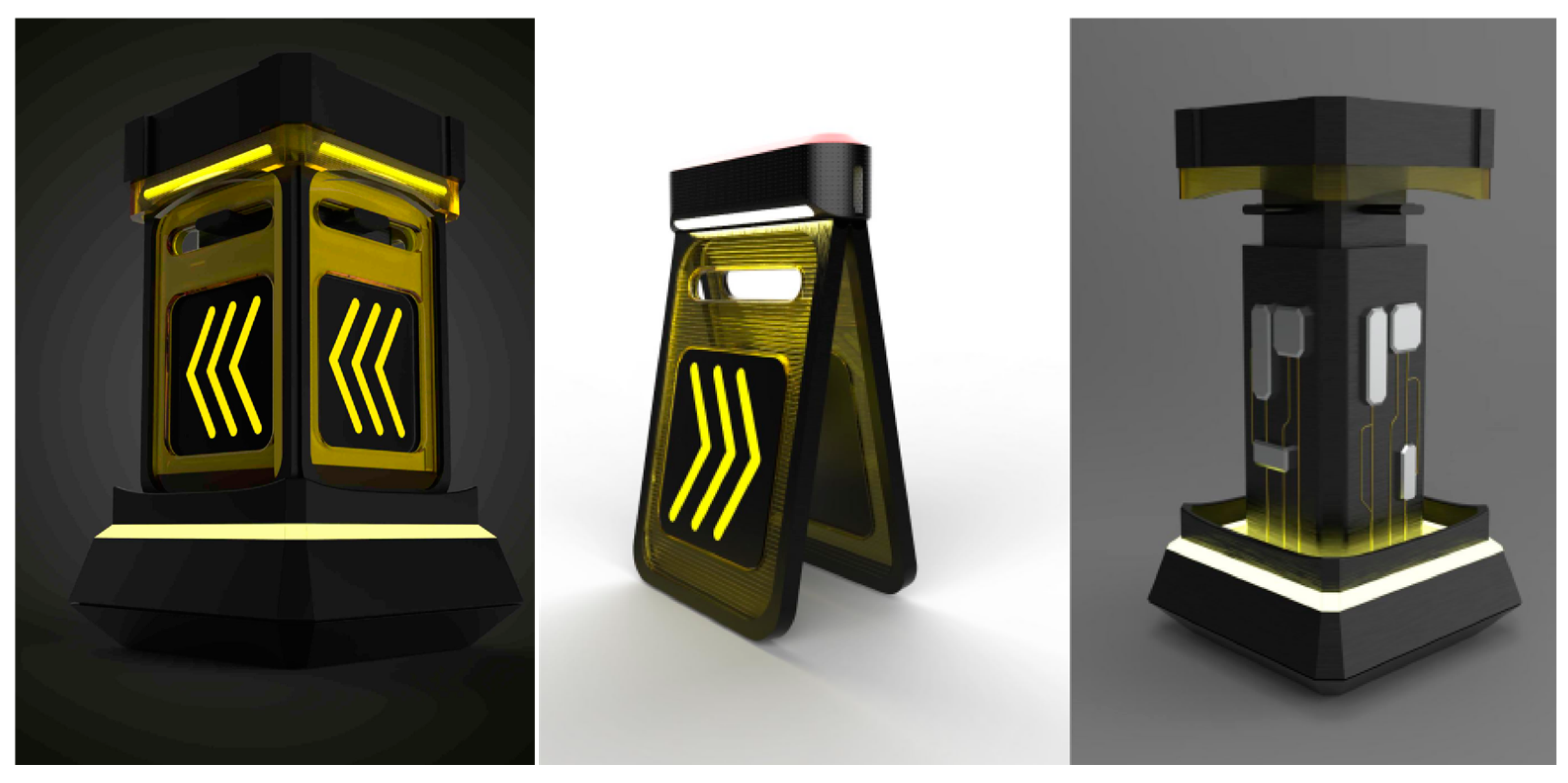

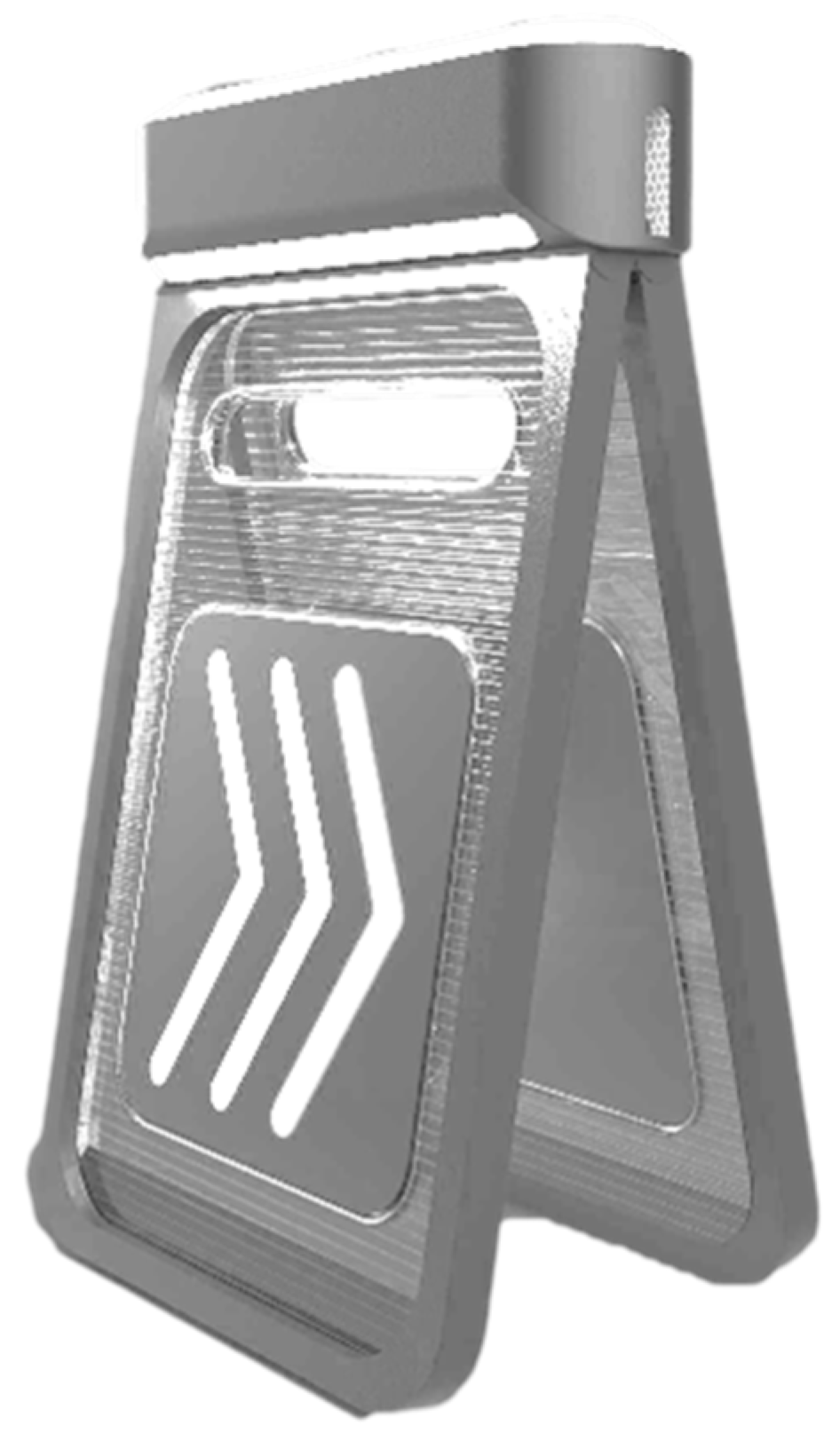


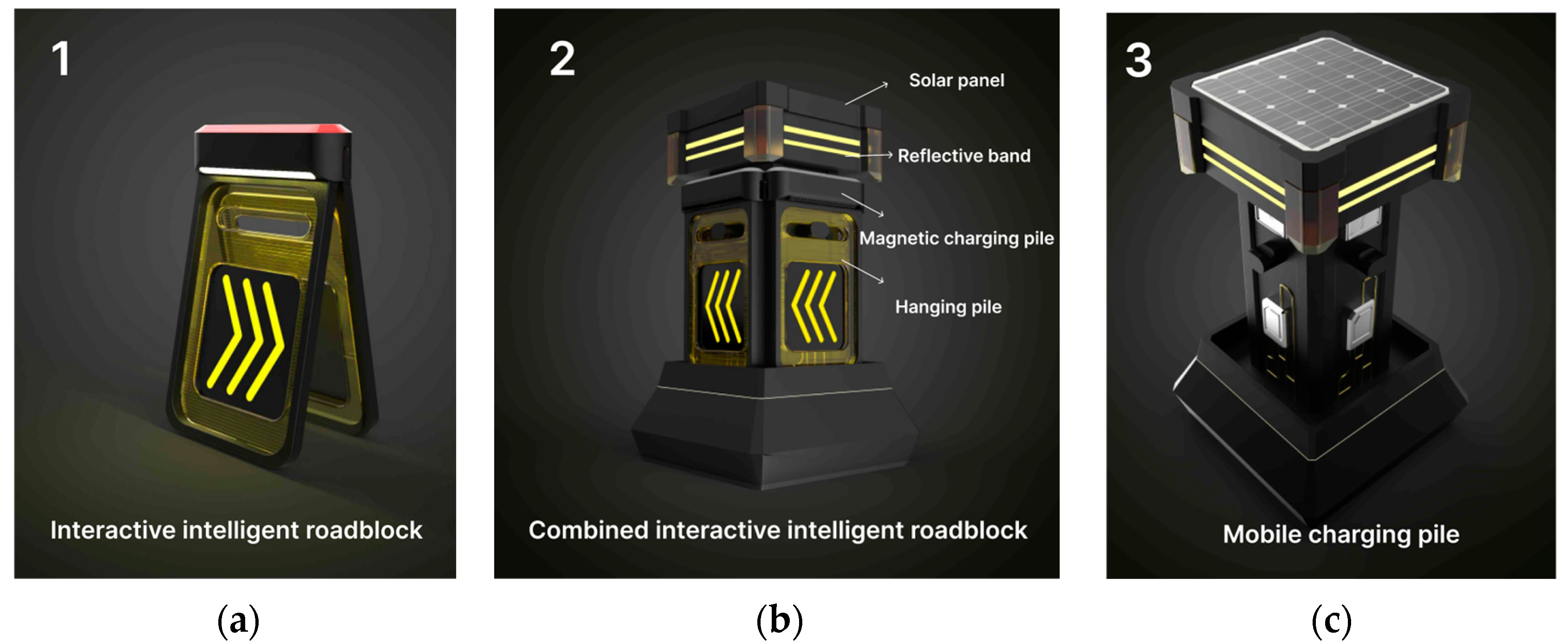

| Roadblock Name | Advantages | Disadvantages | Roadblock Picture |
|---|---|---|---|
| Conical roadblock | Have a warning effect | Lacks aesthetic integration with the urban environment |  |
| A folding barricade | Easy to carry and store, can be quickly reconfigured | Limited interactivity and warning functions | 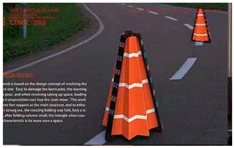 |
| Mobile barrier | Can be quickly moved and redeployed | Insufficient visibility at night without additional lighting |  |
| Solar roadblock | Powered by solar panels, often equipped with LED lights | May be less visible in poor lighting conditions if the solar panel is obscured | 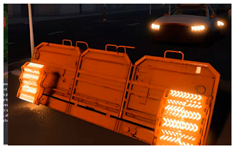 |
| Automatic inflatable barricades | Rapid deployment and easy portability due to inflatable design | Aesthetics may be limited and may require maintenance to ensure proper inflation and deflation | 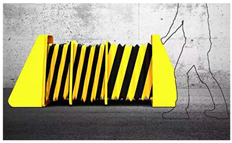 |
| Guardrail barrier | Can be temporarily set up around emergency repair areas | Similar to guardrails, may not provide sufficient visual warnings | 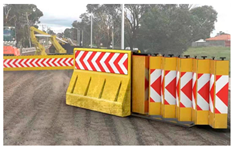 |
| Sound–light warning barrier | Equipped with an audible alarm device to alert drivers | May not be effective if drivers have their windows up or are otherwise unable to hear the alarm | 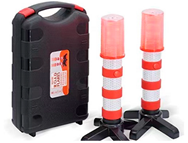 |
| Eco-friendly material barrier | Made of recycled or biodegradable materials | May not be as durable or visible as other materials | 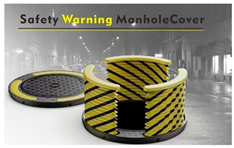 |
| Modular roadblock | Can be quickly assembled and disassembled as needed | May require more time for setup and takedown compared to other types of barricades | 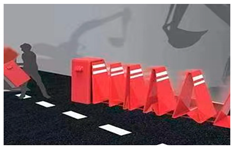 |
| Planned Number | 1 | 2 |
|---|---|---|
| Gaze Points | 170 | 188 |
| Variance of gaze point duration | 0.22 | 0.31 |
| Average duration of gaze points (s) | 6.51 | 6.78 |
| Purity (%) | 1/(170/10/1) × 100% = 5.88% | 1/(188/10/1) × 100% = 5.32% |
| Ratio (s) | 1/0.22 = 4.55 | 1/0.31 = 3.23 |
| Contrast (s) | 170 × 0.22/10 = 3.74 | 188 × 0.31/10 = 5.83 |
| C/T | 3.74/6.51 = 0.57 | 5.83/6.78 = 0.86 |
| Planned Number | Average Duration of Gaze Point T (s) | Gaze Points | Purity (%) | Variance (Statistics) | Proportion (%) | Contrast (s) | C/T |
|---|---|---|---|---|---|---|---|
| 1 | 6.51 | 170 | 5.88% | 0.22 | 4.55 | 3.74 | 0.57 |
| 2 | 6.78 | 188 | 5.32% | 0.31 | 3.23 | 5.83 | 0.86 |
| 3 | 6.62 | 143 | 6.99% | 0.27 | 3.70 | 3.86 | 0.58 |
| 4 | 6.71 | 184 | 5.43% | 0.25 | 4.00 | 4.60 | 0.69 |
| 5 | 6.64 | 178 | 5.62% | 0.23 | 4.35 | 4.09 | 0.62 |
| 6 | 6.43 | 169 | 5.92% | 0.29 | 3.45 | 4.90 | 0.76 |
| 7 | 6.49 | 182 | 5.49% | 0.32 | 3.13 | 5.82 | 0.90 |
| 8 | 6.55 | 223 | 4.48% | 0.3 | 3.33 | 6.69 | 1.02 |
| 9 | 6.85 | 199 | 5.03% | 0.28 | 3.57 | 5.57 | 0.81 |
| 10 | 6.89 | 156 | 6.41% | 0.22 | 4.55 | 3.43 | 0.50 |
Disclaimer/Publisher’s Note: The statements, opinions and data contained in all publications are solely those of the individual author(s) and contributor(s) and not of MDPI and/or the editor(s). MDPI and/or the editor(s) disclaim responsibility for any injury to people or property resulting from any ideas, methods, instructions or products referred to in the content. |
© 2024 by the authors. Licensee MDPI, Basel, Switzerland. This article is an open access article distributed under the terms and conditions of the Creative Commons Attribution (CC BY) license (https://creativecommons.org/licenses/by/4.0/).
Share and Cite
Zhu, X.; Zhao, X.; Yang, J.; Du, X.; Sun, B. Improving Highway Emergency Repair Safety: Design and Evaluation of Interactive Roadblocks Based on Eye Tracking. Appl. Sci. 2024, 14, 7120. https://doi.org/10.3390/app14167120
Zhu X, Zhao X, Yang J, Du X, Sun B. Improving Highway Emergency Repair Safety: Design and Evaluation of Interactive Roadblocks Based on Eye Tracking. Applied Sciences. 2024; 14(16):7120. https://doi.org/10.3390/app14167120
Chicago/Turabian StyleZhu, Xiaohan, Xuandong Zhao, Jianming Yang, Xiaofei Du, and Bowen Sun. 2024. "Improving Highway Emergency Repair Safety: Design and Evaluation of Interactive Roadblocks Based on Eye Tracking" Applied Sciences 14, no. 16: 7120. https://doi.org/10.3390/app14167120







